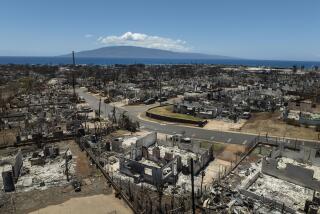Families Settling Land Go Back to Basics
- Share via
HONOLULU — For Donna Simpson and her 9-year-old daughter, their dream home is a far cry from that of most Americans.
“Dream home” for them means a stone house without water or electricity in a scattered community where they can hunt, gather and farm, just as their Hawaiian ancestors did centuries ago.
The Simpsons are among the 16,000 people who have been waiting and hoping for decades that they survive long enough to live on land their ancestors did.
Now, they will be one of 125 Hawaiian families who finally have the chance to live the native way.
By the end of the summer, the families will resettle 23,000 acres of barren land known as Kahikinui.
“My ancestors are from Kahikinui. That’s why we want to go back home,” Simpson said.
On a slice of land that runs from the dormant volcano Haleakala to the sea on the island of Maui, a community will be living a primitive lifestyle under the old Hawaiian-style land concept, known as ahupuaa. It provides people with game, building materials, water and gardens from the forest and the ocean.
For the last 75 years, people of at least 50% Hawaiian blood have been on a waiting list for land that was set aside for the benefit of native Hawaiians by Congress in 1921.
Some have died waiting for the state to put in roads, running water and other improvements on Hawaiian homelands.
Now, there’s no more time to wait, Simpson said.
For the first time, the state is letting a native Hawaiian group develop land by themselves, said Aric Arakaki of the state Department of Hawaiian Home Lands, which administers 200,000 acres set aside for native Hawaiians.
The state has been slow to develop the land because of a chronic shortage of money. Most of the land is in the poorest and most remote areas, and the cost of preparing it for homesteading is expensive, Arakaki said.
Some Hawaiians say they will be satisfied with living on bare land.
“Hawaiians just want to be caretakers of the land again,” said Mo Moler, spokesman for the native Hawaiian group Ka Ohana O Kahikinui. The group is made up of about 30 people who have volunteered to get the land ready.
Under the new program, the state is letting native Hawaiian families lease undeveloped areas for $1 per acre for 99 years to provide them immediate access to land. Families will be awarded the land late this year, Arakaki said.
“The state is affording Hawaiians of today the opportunity to live on undeveloped land and be responsible for the aina [land],” Moler said. “These people don’t want to live in the city, but in the country where their ancestors used to live.
“This is about going back to the basics, culturally, physically and spiritually.”
Water will be collected in catchment systems using fog around the mountain. Energy would come from solar-powered instruments, and a transmitter will provide communications, Moler said.
The homes will use solar heating, composting toilets, wind energy and water-saving techniques, Moler said.
“This type of living is not for everyone,” Simpson said. “Everything you do there is going to be critical” to how the families survive on the land.
A yearlong survey has uncovered thousands of sites that indicate a large population of Hawaiians once lived on the area. Among the items found are heiau [religious shrines], house sites, graves, fish bones and stone tools, Arakaki said.
The group is also working to restore the nearby 7,000-acre Kahikinui Forest, which was damaged when Westerners’ goats, pigs and cattle over-browsed the area.
Replanting efforts are showing some sign of hope.
“Old-timers now drive by and say to me how amazed they are that Kahikinui has life again,” Moler said.
More to Read
Sign up for Essential California
The most important California stories and recommendations in your inbox every morning.
You may occasionally receive promotional content from the Los Angeles Times.













